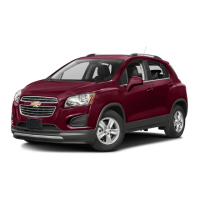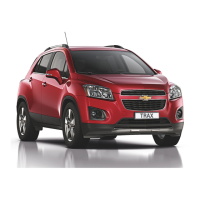Do you have a question about the Chevrolet TRAX 2015 and is the answer not in the manual?
Discusses driver behavior, environment, and vehicle design for safe driving.
Explains hazard symbols and messages to avoid risks and reduce harm.
Describes symbols used on vehicle components and labels for information.
Provides a chart of common vehicle symbols and their meanings.
Describes the instrument panel layout and its components.
Provides an overview of important features for initial vehicle operation.
Details on operating vehicle keys, doors, and windows for access and security.
Outlines various vehicle features available for driver use and comfort.
Covers essential information on vehicle performance and routine maintenance.
Details on vehicle keys, locks, and their operation for security and access.
Information on operating vehicle doors, including liftgate functionality.
Covers vehicle security features like alarm systems and immobilizers.
Information on adjusting and using exterior mirrors for optimal visibility.
Details on adjusting interior rearview mirrors for clear rear visibility.
Instructions on operating power windows, including express features.
Information regarding the vehicle's sunroof operation and maintenance.
Guidance on proper installation and adjustment of head restraints for occupant safety.
Details on adjusting front seats for driver and passenger comfort and position.
Information on rear seat functionality, including folding for cargo space.
Comprehensive guide on using safety belts properly and their importance.
Explanation of the airbag system, its components, and how it functions.
Guidelines for selecting and installing child restraints for optimal safety.
Details on various storage compartments within the vehicle for organization.
Information on features designed to expand storage capacity and organization.
Guidance on using the roof rack system for carrying external loads.
Overview of essential controls for operating the vehicle's functions.
Explains dashboard warning lights, gauges, and indicators for vehicle status.
Details on vehicle information displays, including the Driver Information Center (DIC).
Information on the trip computer for monitoring driving statistics like speed and fuel economy.
Covers options for personalizing vehicle settings and features.
Details on exterior lighting controls, including headlamps and signals.
Information on interior lighting controls for cabin ambiance and visibility.
Covers specific lighting features like battery load management and power protection.
Introduces the infotainment system and its key features for drivers.
Explains the electronic security system designed to prevent theft of the infotainment system.
Guides on operating the infotainment system using controls and menus.
Covers AM-FM radio functions, satellite radio, and reception.
Information on connecting and using audio players like CD, USB, and auxiliary devices.
Details on using Bluetooth for hands-free calling and voice recognition.
Information on smartphone link applications like Pandora and Stitcher.
Covers connecting and controlling Bluetooth devices for audio and phone functions.
Lists trademarks and license agreements related to the infotainment system software.
Key factors influencing vehicle performance and safety, including driver behavior.
Guidelines for new vehicle break-in, ignition positions, and starting the engine.
Information on engine exhaust systems and potential hazards like carbon monoxide.
Details on operating the automatic transmission, including manual mode.
Instructions for operating a manual transmission vehicle, including shifting and clutch use.
Information on drive systems like All-Wheel Drive (AWD) for enhanced performance.
Comprehensive details on the braking system, including ABS and brake assist.
Covers Traction Control and Electronic Stability Control systems for maintaining vehicle control.
Instructions on using the cruise control system for maintaining speed.
Information on driver assistance systems like parking assist and rear vision cameras.
Guidance on recommended fuel types, additives, and filling the tank.
General information and precautions regarding towing vehicles.
Advice on adding electrical equipment and potential impacts on vehicle systems.
General information about vehicle service, parts, and dealer recommendations.
Guides on performing routine vehicle checks and basic service tasks.
Information on headlamp aim adjustment and when dealer service may be needed.
Instructions for replacing various vehicle bulbs, including safety precautions.
Details on the electrical system, including fuses, circuit breakers, and overload protection.
Comprehensive information on tires, including selection, maintenance, and replacement.
Information on vehicle identification numbers (VIN) and service parts labels.
Details on vehicle capacities and specifications, including fluids and torque.
Technical specifications for engine types, VIN codes, transmissions, and spark plug gaps.
Diagrams illustrating engine drive belt routing for different engine configurations.
Guidelines for ensuring customer satisfaction and resolving concerns with dealers.
Procedures for reporting safety defects to government agencies and General Motors.
Information on vehicle data recording, privacy, and event data recorders (EDRs).
Overview of OnStar services, including emergency, security, and navigation features.
Provides a general overview of the OnStar system and its capabilities.
Details the various OnStar services available, such as Emergency and Security.
Contains additional information related to OnStar services and vehicle integration.
Explains how OnStar performs vehicle checks and diagnostics for key systems.
Discusses driver behavior, environment, and vehicle design for safe driving.
Explains hazard symbols and messages to avoid risks and reduce harm.
Describes symbols used on vehicle components and labels for information.
Provides a chart of common vehicle symbols and their meanings.
Describes the instrument panel layout and its components.
Provides an overview of important features for initial vehicle operation.
Details on operating vehicle keys, doors, and windows for access and security.
Outlines various vehicle features available for driver use and comfort.
Covers essential information on vehicle performance and routine maintenance.
Details on vehicle keys, locks, and their operation for security and access.
Information on operating vehicle doors, including liftgate functionality.
Covers vehicle security features like alarm systems and immobilizers.
Information on adjusting and using exterior mirrors for optimal visibility.
Details on adjusting interior rearview mirrors for clear rear visibility.
Instructions on operating power windows, including express features.
Information regarding the vehicle's sunroof operation and maintenance.
Guidance on proper installation and adjustment of head restraints for occupant safety.
Details on adjusting front seats for driver and passenger comfort and position.
Information on rear seat functionality, including folding for cargo space.
Comprehensive guide on using safety belts properly and their importance.
Explanation of the airbag system, its components, and how it functions.
Guidelines for selecting and installing child restraints for optimal safety.
Details on various storage compartments within the vehicle for organization.
Information on features designed to expand storage capacity and organization.
Guidance on using the roof rack system for carrying external loads.
Overview of essential controls for operating the vehicle's functions.
Explains dashboard warning lights, gauges, and indicators for vehicle status.
Details on vehicle information displays, including the Driver Information Center (DIC).
Information on the trip computer for monitoring driving statistics like speed and fuel economy.
Covers options for personalizing vehicle settings and features.
Details on exterior lighting controls, including headlamps and signals.
Information on interior lighting controls for cabin ambiance and visibility.
Covers specific lighting features like battery load management and power protection.
Introduces the infotainment system and its key features for drivers.
Explains the electronic security system designed to prevent theft of the infotainment system.
Guides on operating the infotainment system using controls and menus.
Covers AM-FM radio functions, satellite radio, and reception.
Information on connecting and using audio players like CD, USB, and auxiliary devices.
Details on using Bluetooth for hands-free calling and voice recognition.
Information on smartphone link applications like Pandora and Stitcher.
Covers connecting and controlling Bluetooth devices for audio and phone functions.
Lists trademarks and license agreements related to the infotainment system software.
Key factors influencing vehicle performance and safety, including driver behavior.
Guidelines for new vehicle break-in, ignition positions, and starting the engine.
Information on engine exhaust systems and potential hazards like carbon monoxide.
Details on operating the automatic transmission, including manual mode.
Instructions for operating a manual transmission vehicle, including shifting and clutch use.
Information on drive systems like All-Wheel Drive (AWD) for enhanced performance.
Comprehensive details on the braking system, including ABS and brake assist.
Covers Traction Control and Electronic Stability Control systems for maintaining vehicle control.
Instructions on using the cruise control system for maintaining speed.
Information on driver assistance systems like parking assist and rear vision cameras.
Guidance on recommended fuel types, additives, and filling the tank.
General information and precautions regarding towing vehicles.
Advice on adding electrical equipment and potential impacts on vehicle systems.
General information about vehicle service, parts, and dealer recommendations.
Guides on performing routine vehicle checks and basic service tasks.
Information on headlamp aim adjustment and when dealer service may be needed.
Instructions for replacing various vehicle bulbs, including safety precautions.
Details on the electrical system, including fuses, circuit breakers, and overload protection.
Comprehensive information on tires, including selection, maintenance, and replacement.
Information on vehicle identification numbers (VIN) and service parts labels.
Details on vehicle capacities and specifications, including fluids and torque.
Technical specifications for engine types, VIN codes, transmissions, and spark plug gaps.
Diagrams illustrating engine drive belt routing for different engine configurations.
Guidelines for ensuring customer satisfaction and resolving concerns with dealers.
Procedures for reporting safety defects to government agencies and General Motors.
Information on vehicle data recording, privacy, and event data recorders (EDRs).
Overview of OnStar services, including emergency, security, and navigation features.
Provides a general overview of the OnStar system and its capabilities.
Details the various OnStar services available, such as Emergency and Security.
Contains additional information related to OnStar services and vehicle integration.
Explains how OnStar performs vehicle checks and diagnostics for key systems.
| Brand | Chevrolet |
|---|---|
| Model | TRAX 2015 |
| Category | Automobile |
| Language | English |











